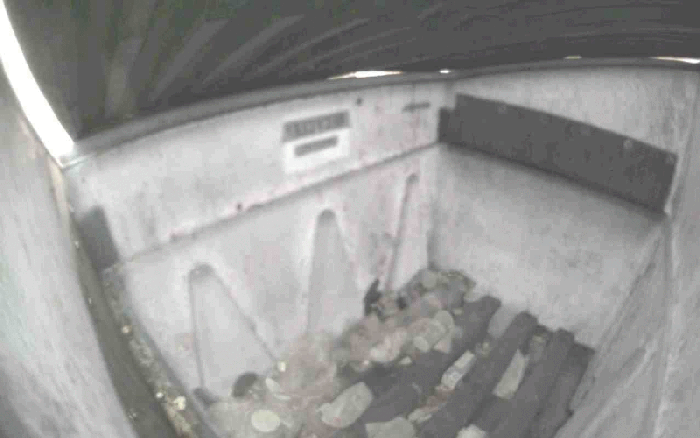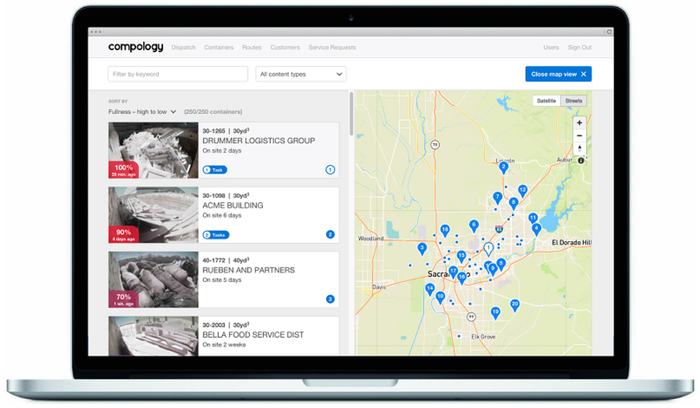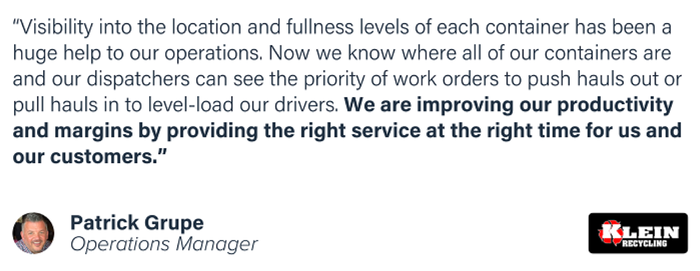Smarter Waste for the Smart City
This article is brought to you by Compology, a provider of container monitoring software for waste haulers.

Sponsored Content
When we hear “Smart City”, we probably picture a sustainable, liveable, and economically healthy environment scoring high on the quality of life scale. We picture efficiency, clean streets, and exceptional city services. We like the idea of smart cities. But how much thought do we give to what it really takes to make a city smart? Do we think about the information and communication technology necessary to more efficiently manage our transportation systems, hospitals, power plants, water supply networks, and waste and recycling services? Or about the fact that 70% of the world’s population is forecasted to live in cities by 2050 and how we must focus our efforts on finding ways for all of our cities to become more efficient and productive? The good news is that the Internet of Things (IoT) and advancements in cloud computing have rapidly accelerated our ability to modernize our cities to collect data and help transform the way they operate. In fact, 1.6 billion connected devices were used in 2016 by smart cities, up 39% from 2015.
When it comes to waste and recycling, Navigant Research projects the smart waste collection technology market to grow from $57.6 million in 2016 to over $223.6 million in 2025 which suggests that waste management and the inevitable need for operational changes in waste collection are a key focus for smart cities.
Right now, cities and businesses are affirming their commitments towards Zero Waste initiatives and hoping to reap the related benefits of reductions in greenhouse gas (GHG) emissions and traffic congestion. Unfortunately, these smart city efforts, both in the U.S. and abroad, have encountered the challenges of the high cost of service and inaccurate measurement techniques. For example, China has announced that it will no longer take “waste” disguised as recycling, California just reported its first drop in statewide diversion since 1989 and Los Angeles businesses are seeing substantial cost increases with implementation of the city’s RecycLA franchise system. Clearly, waste and recycling systems must adapt to meet new demands of actionable information and entire system connectivity. The simple solution? IoT devices.
Today, most waste collection systems operate on a set pick-up schedule, regardless of whether a waste or recycling container actually needs to be emptied or not. With the exception of periodic and infrequent manual assessments, cities and haulers have little visibility into the type and quantity of materials that generators are dumping into their containers. Both the set schedule and the lack of abundant, quality data lead to a laundry list of inefficiencies such as unproductive use of hauler resources (like trucks and containers), low diversion rates and unnecessary spending. This presents a tremendous opportunity for municipalities to work with collection operations and haulers to address these inefficiencies with modern technology in the form of image-based container sensors. For waste haulers, implementing waste sensors means not only cost savings and improved operational productivity, but also the opportunity to use accurate and abundant data and insights to join in conversation with governmental policy makers and businesses to shape regulations and requirements that result in mutually beneficial waste management policies for years to come.
The Smartest Waste Monitoring Solution
Container-mounted sensors are the most effective way to know exactly what is happening inside a waste container. While there are a variety of sensors that can provide fullness and location monitoring, Compology offers the only image-based sensor that collects real-time images of the contents of a container and provides access to them, as well as current and historical fullness data, through its web-based software. For the purposes of Zero Waste and diversion oversight, images are absolutely critical to the solution.
(Read More: The benefits of image-based container monitoring sensors)
In addition to image-based fullness and container content monitoring, these container-mounted sensors also track GPS location and motion-based service verification data, all of which can be accessed through web-based software and easily shared with municipalities and customers for reporting and analysis. Let’s take a closer look at the advantages for cities, haulers and businesses when implementing container-mounted waste sensors.
(Send a note to learn more about Compology’s image-based approach)

Actual Compology sensor images providing a first-hand look at the contents of any container.
Smarter Cities
Traditionally, municipalities dedicate significant resources to measure, oversee and enforce Zero Waste and environmentally-focused policies, but implementation and enforcement can be difficult because of the scale of programs and limited information. Let’s take the city of Los Angeles as an example. Los Angeles has various recycling and diversion policies and laws, and is in the process of implementing its new RecycLA program to achieve a goal of 90% diversion by 2025. The RecycLA program seeks success, in part, by mandating over 80,000 manual waste assessments be conducted by franchise haulers every 6 months to gain information about how generators are using recycling and organics containers as required by law. In effect, every customer is assessed twice a year, but the city and the franchise haulers could greatly benefit from more abundant data. IoT devices present a new opportunity for timely, accurate data acquisition without the need for manual assessments. With image-based sensors, data will be automatically and continuously collected 365 days a year, instead of just two, and with the ability for waste assessment professionals to peer into any and all containers online through a web-based software platform, there’s no need to spend more dollars putting boots on the streets.
Effective Oversight & Regulation Enforcement for Sustainability Policies
Image-based sensors eliminate the need for costly, inefficient assessments by giving visibility to every container in a city in real-time. These sensors collect more frequent, accurate and historical waste data giving cities the ability to study diversion and recycling trends as well as contamination levels of waste for each and every business location. With this information, government officials can gain actionable insights and work with businesses to create more effective and efficient environmentally-friendly policies.
Stronger Communication & Shared Learnings
Using images to analyze the contents of a container, predict utilization, and identify contamination over a period of time can help cities identify trends and use targeted communication and outreach efforts to those businesses that may not be meeting local obligations, while also sharing learnings from and rewarding businesses that are leading successful diversion and recycling campaigns.
Efficient Spending
Rather than conducting 80,000 audits over 6 months, cities such as Los Angeles, can remotely access all the information they need to track and analyze fullness and location data as well as view historical images to monitor contamination and recycling habits by simply logging onto the Compology website. With more productive use of resources, cities can redirect funds to other city programs.

Web-based access to container location, fullness and container content data.
Smarter Haulers
Currently, most municipal waste collection operations focus on emptying containers according to set schedules. Inevitably this leads to inefficiencies with partially-full bins being serviced, poor use of hauler assets, and unnecessary spending from both the hauler and customer perspective. With advancements in modern technology and the growing demand for environmentally-efficient business practices from cities, constituents and businesses alike, waste haulers must prepare to adapt to inevitable industry changes. Accurate, real-time data collection through container-based waste sensors, like Compology, will help haulers meet regulatory requirements with location, fullness and service verification data, while also increasing their own operational efficiency.
Streamlined Operations & Efficient Spending
For haulers, location, fullness and utilization data means knowing when each specific container will need service. This allows operations managers to organize routing, maximize truck and container usage, and in turn, minimize costs through reduced fuel usage, less truck wear and tear and elimination of unnecessary spending through automated inventory management.

Timely Service & Corporate Social Responsibility
With location and fullness container data, haulers can anticipate customer service needs and conduct pick-ups in a more timely manner. Providing service proactively and only as needed also allows haulers to become stronger corporate citizens. With trucks on the road only as needed, haulers can lower truck carbon emissions while reducing wear and tear on city roads. Additionally, timely service helps remove garbage from public spaces quickly, keeping cities clean and odorless. And a willingness to coordinate and share access to data with cities and businesses, helps achieve recycling and diversion goals.
Haulers willing to be early adopters of container sensor technology will benefit from working more closely with government officials and businesses to form realistic regulatory requirements and waste service agreements, all while improving their own operational practices and increasing customer loyalty through an enhanced service offering.
Smarter Businesses
By 2025, Millennials will represent 75% of the American workforce and represent $2.45 trillion in potential spending power. This powerful demographic not only prefers to work for companies that are socially responsible, but is also more willing to purchase products from companies that are making a positive social contribution. This trend, along with the increased regulations by municipalities for Zero Waste and diversion initiatives, makes social responsibility a vital focus for businesses. The issue, however, when it comes to diversion and recycling initiatives, is the ability, or lack thereof, to accurately measure their success. Whether it’s to be a responsible corporate citizen or to meet regulations, data collected from container-based waste sensors can be the solution environmentally conscious businesses are looking for.
Effective Oversight, Shared Learnings & Corporate Social Responsibility
Access to historical container content images tied to specific business locations gives corporate sustainability leaders the ability to monitor and gather insight into waste practices at an individual, regional or corporate-wide level. By analyzing historical data, businesses can track trends like reduction in overall waste creation or increases in diversion rates.

Just as cities would use this data to enforce regulations, businesses can similarly measure performance over time and share learnings to improve corporate wide practices and meet their own internal sustainability policies.
. . .
To learn more about Compology’s approach to container monitoring and how it applies specifically to your organization or to schedule a demo, please send us a note and make sure to subscribe to our blog for more information.
About the Author
You May Also Like


.png?width=300&auto=webp&quality=80&disable=upscale)